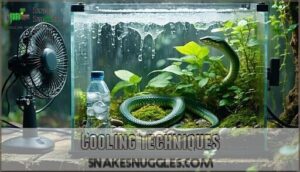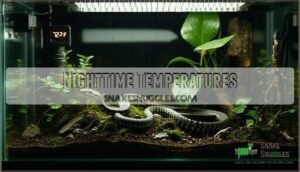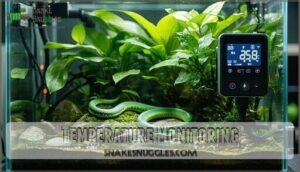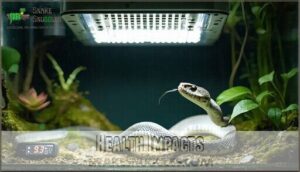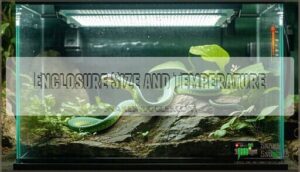This site is supported by our readers. We may earn a commission, at no cost to you, if you purchase through links.

You’ll want to create a temperature gradient, so your snake can regulate its body temperature. Getting this right is vital, as incorrect temperatures can affect your snake’s health.
You’ll need to examine heating methods, cooling techniques, and humidity control to create an ideal environment. Now, let’s get into the specifics of creating a comfortable and healthy space for your pet snake.
Table Of Contents
- Key Takeaways
- Snake Tank Temperature
- Heating Methods
- Cooling Techniques
- Temperature Extremes
- Humidity Control
- Species Specific Temperatures
- Nighttime Temperatures
- Temperature Monitoring
- Health Impacts
- Tank Setup Guidelines
- Frequently Asked Questions (FAQs)
- How hot should a snake tank be?
- How do you heat a snake tank?
- Can a snake control water temperature?
- How cold is too cold for a snake to stay active?
- What temperature should a snake be outside?
- Do snakes need a heating tank?
- Can you leave a heat lamp on 24/7 for ball python?
- What temperature do snakes like best?
- What temperature should a snake be at night?
- What affects snake metabolism rates?
- Conclusion
Key Takeaways
- You need a temperature gradient in your snake tank, with a warm side (80–95°F, depending on species) and a cool side (around 75°F) so your snake can thermoregulate.
- Always use reliable thermometers and thermostats to monitor and control the tank’s temperature, protecting your snake from dangerous swings or extremes.
- Every snake species has its own ideal temperature; check specific needs to avoid health issues from being too hot or too cold.
- Don’t forget humidity—keep it within species-appropriate ranges using misting systems or moisture-retentive substrates to ensure proper shedding and respiratory health.
Snake Tank Temperature
Getting the temperature right in your snake’s tank isn’t just important—it’s essential for your pet’s health and happiness.
Temperature control is key to your snake’s health and happiness always
Without proper heating, your snake can’t digest food properly, fight off infections, or even move normally.
Ideal Temperature Range
Understanding ideal snake tank temperature starts with knowing your snake’s basic needs.
Know your snake’s needs for a happy and healthy pet
Most snakes thrive with a temperature range between 75-95°F, but getting this right isn’t just about picking random numbers.
Here’s what proper temperatures deliver:
- Health protection – correct temps boost immune function and prevent deadly infections
- Smooth digestion – warm bellies process food efficiently, avoiding dangerous blockages
- Natural behavior – snakes can thermoregulate just like in the wild
- Stress reduction – comfortable temps mean relaxed, content snakes
Your snake’s ideal temperature depends on species, but ambient temperature should stay between 75-80°F on the cool side.
The basking temperatures need to hit 85-95°F for most species.
This ideal temperature creates the foundation for thermoregulation benefits that keep your snake healthy and active.
Temperature Gradients
Creating a proper temperature gradient means setting up your snake tank with a warm side ranging 80-85°F and a cool side at 75°F.
This gradient setup mimics natural behavior, letting your snake move between heat sources to regulate body temperature.
Species variation affects specific ranges, while vertical gradients provide additional basking area options for ideal thermoregulation.
For corn snakes, it’s important to maintain a basking spot temperature between 88-92°F.
Importance of Thermoregulation
Thermoregulation drives your snake’s survival through metabolic processes and enzyme efficiency.
Without proper snake temperature control, your pet can’t digest food or fight infections effectively.
Behavioral thermoregulation lets snakes choose their ideal body temperature by moving between warm and cool zones.
This natural habitat selection mimics their physiological adaptations from the wild, making temperature regulation absolutely essential for health.
Heating Methods
You’ll need the right heating methods to keep your snake healthy, since reptiles rely on their environment for warmth.
From heat mats to ceramic heat emitters and basking bulbs, each option helps you control tank temperature and meet your pet’s needs.
Heat Mats
Your snake’s comfort starts with smart heat mat placement. Always use a thermostat control to prevent overheating and burns.
Check mat wattage to match your tank size—too much power can spike snake tank temperature. Under tank heaters work well for many species, but always check species suitability.
Heat mats offer steady snake tank heating, keeping your pet’s enclosure temp just right. For ideal temperature control, consider using automatic reptile thermostats to ensure the best environment for your pet.
Ceramic Heat Emitters
A ceramic heat emitter (CHE) works wonders for keeping your snake enclosure temp steady, especially at night.
Unlike a heat lamp for snakes, CHEs emit heat without light, making them ideal for nocturnal warmth.
Choose the right CHE wattage for your tank size, always pair with a reptile thermostat for CHE safety, and monitor snake tank temperature closely.
These emitters are designed to simulate the sun by providing natural infrared heat.
Basking Bulbs
Looking beyond traditional heating methods, basking bulbs deliver concentrated light spectrum heat that mimics natural sunlight for your snake basking spot.
These heat lamp options create focused basking areas with proper basking distance being essential—typically 6-12 inches depending on bulb wattage.
Consider bulb lifespan and safety concerns when selecting your heat lamp snakes setup, as higher wattages require careful temperature monitoring.
Under-Tank Heaters
Under-tank heaters (UTHs) stick beneath your enclosure, providing consistent belly heat that aids digestion.
Always use thermostat control with your undertank heating pad to prevent snake burns.
Place a substrate barrier between the UTH and your pet, and choose appropriate UTH wattage for your tank size.
These heat sources create natural warmth snakes seek when setting up reptile heating systems.
Cooling Techniques
When your snake’s tank gets too warm, you’ll need reliable ways to bring the temperature down safely.
Let’s look at simple cooling techniques that keep your pet comfortable, especially during hot weather.
Frozen Water Bottles
When overheating strikes, frozen water bottles offer a safe and quick fix for snake tank cooling.
For effective, gradual cooling, place bottles on the mesh top—not inside—so cool air drops safely. Rotate bottle size and number for longer cooling duration.
Proper ventilation is also essential to prevent humidity buildup. Always check that condensation stays outside, and swap bottles to keep a steady snake tank temperature using this simple emergency cooling method.
Fans and Damp Towels
If frozen bottles aren’t cutting it, try air circulation with a small fan and drape a cool, damp towel over the enclosure (not inside).
This combo ramps up evaporation cooling and drops your snake tank temperature by several degrees.
Monitor humidity impact, check towel placement, and always use fan safety measures.
These cooling methods make snake tank temperature regulation easier—much less drama, using fan safety measures.
Spraying Cool Water
Ever wondered how a quick spray can tame heat spikes? Using water for Evaporation Cooling helps stabilize snake temperature and humidity.
Try these steps:
- Mist lightly with room-temperature water (don’t soak the snake).
- Stick to a sensible Spraying Frequency—target hot afternoons.
- Monitor for Scale Health, as too much dampness can harm snake sensitivity.
Temperature Extremes
If your snake’s tank gets too hot or cold, you’re setting up health problems faster than they can flick their tongue.
Staying on top of temperature extremes protects your snake from stress, illness, and an unhappy tank escape attempt, which is crucial for maintaining a healthy environment, and illness can be prevented by proper temperature control.
Overheating Risks
Lost your cool? So can your snake.
Cranking up the heat can lead to overheating fast—watch for lethargy signs and heatstroke symptoms like heavy breathing or listlessness.
If basking areas pass fatal temperatures above 95°F, burns and dehydration risk shoot up.
Control snake tank temperature closely and protect your pet, as burn prevention really is no joke.
Hypothermia Effects
When snake tank temperature drops too low, you’ll start to see sluggishness signs—your snake moves less and acts tired.
Chronic hypothermia puts their health at risk: digestion issues show up, immune suppression becomes real, and infection risk rises.
If reptile temperature plunges far enough, fatal temperatures can strike.
Keep your snake’s tank warm—don’t let cold sneak in!
- Sluggishness signs appear
- Digestion issues develop
- Immune suppression increases
- Infection risk rises
- Fatal temperatures can occur
Immune System Impact
When reptile temperature drops too low, hypothermia effects don’t just slow your snake’s metabolism—they also mess with the snake immune system.
Poor temperature regulation leads to a weak immune response, making your snake more prone to infection susceptibility and chronic stress.
To keep snake health on track, keep an eye on your snake temperature for peace of mind.
Humidity Control
You’ll want to keep an eye on humidity, since snakes need the right balance to shed properly and stay healthy.
Don’t be surprised if your snake seems to enjoy a good misting or a moist hide, as many thrive with a little extra humidity in their tank.
Ideal Humidity Levels
Maintaining proper humidity levels keeps your snake healthy and comfortable.
Ball pythons thrive at 50-60% humidity, while corn snakes need 40-50% to prevent respiratory issues.
Use a hygrometer to monitor levels accurately.
During shedding, boost humidity to 70-80% for shedding success.
Choose moisture-retentive substrates like cypress mulch for better humidity control throughout the enclosure.
Misting Systems
You’ll find misting systems come in two main flavors: manual spray bottles and automated setups.
Manual misting gives you complete control but requires daily attention. Automated systems maintain humidity consistency through programmable timers and various nozzle types.
Choose quality water to prevent mineral buildup on glass. Regular maintenance keeps nozzles clean and prevents bacterial growth in your snake’s environment, ensuring a healthy space through proper humidty consistency.
Substrate Selection
Your substrate choice affects both heat distribution and moisture retention in your snake’s enclosure.
Cypress mulch and coconut fiber excel at holding humidity while allowing proper burrowing behavior. Aspen shavings provide excellent substrate insulation but absorb less moisture.
Avoid cedar or pine, which release harmful oils. Paper towels work temporarily but don’t support natural behaviors.
Choose substrates that complement your reptile temperature control system for ideal snake safety.
Species Specific Temperatures
Each snake species has unique temperature needs that you’ll want to match closely for ideal health.
Getting these specifics right makes the difference between a thriving pet and ongoing health problems.
Ball Python Requirements
Ball pythons need precise conditions to thrive in captivity.
These African natives require warmer temperatures than many snake species, with specific humidity needs for proper shedding.
Your ball python’s temperature gradient should include:
- Warm side: 90-95°F (32-35°C) for proper basking behavior
- Cool side: 75-80°F (24-27°C) for thermoregulation
- Nighttime: Can drop to 70°F safely
- Humidity: 60-80% to prevent shedding issues
Enclosure size affects temperature stability, with larger tanks requiring more powerful reptile tank heaters for consistent gradients.
Corn Snake Requirements
Corn snake care isn’t just about feeding habits or solving shedding issues—it all starts with the right snake tank temperature.
Keep the gradient 75–85°F by day, with a basking spot near 90°F.
Night temps can drop to 75°F.
Smart enclosure size prevents stress, while proper temperatures help prevent common illnesses.
Breeding temperatures need strict control.
| Factor | Recommendation |
|---|---|
| Day Temperature | 75–85°F (24–29°C) |
| Basking Spot | 90°F (32°C) |
| Night Temperature | 75°F (24°C) |
| Gradient | Warm Side/Cool Side |
Boa Constrictor Requirements
Boa constrictors are gentle giants that need special care.
For their size and calm temperament needs, keep your snake tank temperature between 82–88°F with a gentle gradient.
Use heat sources like ceramic emitters for even warmth.
Feed responsibly—these boas can live 20–30 years.
Adequate enclosure size and reliable temperature control make every boa thrive.
Nighttime Temperatures
You’ll need to let nighttime temperatures drop a bit, since most snakes are used to cooler nights in the wild.
Don’t worry, your snake won’t need a blanket, but keeping the tank above 70°F guarantees healthy sleep and safe digestion.
Safe Temperature Drops
Different snake species handle temperature changes in their own way, just like people tolerating a chilly morning.
At night, don’t let the tank get too cold. Follow these snake temperature guidelines for safe, gradual cool downs:
- Prioritize species tolerance
- Monitor for controlled drops
- Consider seasonal variation
- Watch health monitoring
- Avoid rapid snake temperature fluctuations
The guidelines are essential for the well-being of the snakes, and it is crucial to adhere to them to prevent any harm.
Ball Python Nighttime Needs
For your ball python, maintain a nighttime temperature gradient, ensuring digestion and comfort.
Nocturnal behavior means they’re active at night, so a temperature range of 70-78°F supports their needs.
Alongside humidity fluctuation control and enrichment activities to mimic their natural habitat, these conditions help ensure the well-being of your pet, with nocturnal behavior being a key aspect of their care.
General Snake Nighttime Guidelines
Most snake species handle nighttime drop temperatures well, with safe reductions to 70°F benefiting their natural circadian rhythms.
However, species variation matters—tropical snakes need warmer nights than temperate ones.
Monitor your snake tank temperature closely during shedding cycle periods, as cooler night temperatures can impact digestion and create health concerns if the temperature gradient becomes too extreme in your snake tank environment, affecting the overall health concerns.
Temperature Monitoring
You’ll need reliable temperature monitoring equipment to maintain your snake’s health and comfort. Digital thermometers and thermostats work together to track temperatures accurately and automatically adjust heating systems when needed.
Digital Thermometers
For accurate snake tank temperature monitoring, you’ll need reliable digital thermometers placed at substrate level.
Modern devices offer features that make temperature tracking straightforward and precise.
- Dual-probe systems – Monitor both warm and cool sides simultaneously
- Data logging capabilities – Track temperature patterns over time
- Remote monitoring options – Check temperatures via smartphone apps
- Calibration methods – Confirm accuracy with regular calibration checks
Consider also the need for reliable digital options for accurate readings.
Placement strategy matters – position probes where your snake spends time, not against glass walls where readings skew.
Thermostats
While digital thermometers tell you what’s happening, thermostats actually control it.
These devices automatically turn heating elements on and off to maintain your snake tank temperature within set parameters.
You’ll want digital thermostats for precise automated control – they’re your reptile’s safety net against dangerous temperature swings.
| Thermostat Types | Best For | Safety Features |
|---|---|---|
| On/Off Digital | Basic setups | Temperature alarms |
| Proportional | Precise control | Gradual adjustments |
| Pulse Proportional | Advanced tanks | Prevents overheating |
| Dimming | Light-based heat | Smooth regulation |
Proper thermostat placement matters – position the probe where your snake spends most time, not directly under the heat source.
Calibrate your thermostat regularly against a separate thermometer to verify accuracy.
This automated control system prevents both overheating and dangerous temperature drops.
Daily Temperature Checks
Once you’ve set your thermostats, make daily temperature checks a habit.
Place your snake tank thermometer at both ends to get consistent readings across the temperature gradient. Jot down these numbers for easy record keeping.
Watch for odd behavior—like extra hiding or restlessness—which means it’s time for an adjustment.
Small tweaks keep your snake tank temperature in the ideal temperature range, ensuring a stable environment is crucial for maintaining the health of your snake, which is why daily temperature checks are essential.
Health Impacts
If your snake’s tank temperature isn’t just right, it can cause all sorts of trouble with their digestion and breathing.
Don’t be surprised if a chilly tank slows your snake down—they’re not trying to win a napping contest, their bodies just don’t work well when it’s too cold or too hot.
Digestion and Temperature
When your snake’s tank hits the right temperature gradient, digestion is smooth sailing.
Enzyme activity and metabolic rate rise, so food absorption gets a boost and gut health stays on track.
Too cold? Undigested meals can rot, causing trouble for your snake.
Keep the warm side to support snake digestion and metabolism—staying close to their ideal body temperature is key for a happy belly.
Regular monitoring can help prevent common digestive problems, and it is crucial to maintain the right temperature for smooth digestion and overall gut health.
Respiratory Health
One big hurdle for snake respiratory health is poor airstream quality—think stuffy, humid rooms with no fresh air.
Humidity levels matter; too much can cause Infection Signs, like wheezing or mucus.
Not enough humidity, and you’ll get Shedding Issues.
Make sure your setup balances snake temperature and snake humidity, uses misting systems smartly, and offers solid ventilation needs.
Good airflow keeps sneezes away and your pet breathing easy.
Tank Setup Guidelines
You’re setting up your snake’s tank, and it’s vital to get the temperature just right.
You’ll need to examine the enclosure size, heating equipment placement, and substrate selection to create a healthy environment for your pet snake.
Enclosure Size and Temperature
When setting up your snake enclosure, consider these factors:
- Enclosure size
- Insulation quality
- Airflow impact.
Make certain adequate space for a temperature gradient, as incorrect enclosure size affects snake tank temperature, impacting your pet’s health and well-being.
Heating Equipment Placement
You’ll want to place heating equipment in ideal locations to create a temperature gradient, ensuring safety precautions are met.
Thermostat placement is vital, considering species needs and the heat lamp or ceramic heat emitter’s role in maintaining the ideal snake tank temperature.
It’s also important to provide essential hiding spots to reduce stress and ensure the overall well-being of the snakes, which is crucial for creating a safe and healthy environment with the right equipment.
Substrate Selection for Temperature Control
Your substrate choice directly impacts snake tank temperature control through thermal conductivity and heat distribution.
Aspen bedding and coconut husk provide excellent substrate insulation while supporting natural burrowing behavior.
Deep layers create stable temperature gradients, letting your snake self-regulate by moving between warmer surface areas and cooler depths.
Moisture retention substrates like cypress mulch enhance both humidity and snake habitat warmth throughout your enclosure, utilizing moisture retention and promoting a stable environment with natural burrowing behavior.
Frequently Asked Questions (FAQs)
How hot should a snake tank be?
You should keep your snake tank between 75-85°F, with a warm side around 90-95°F for tropical species like ball pythons, to guarantee proper thermoregulation and comfort.
How do you heat a snake tank?
Like a master chef, you’ll whip up a warm haven using heat mats, ceramic heat emitters, or under-tank heaters, ensuring your snake’s comfort and happiness.
Can a snake control water temperature?
You can’t control water temperature directly, but you can use lukewarm water or a water heater to achieve a comfortable temperature for your snake’s soaking needs.
How cold is too cold for a snake to stay active?
You’ll find snakes get sluggish below 60°F, as chemical reactions slow, making it too cold for them to stay active, so make certain their environment stays above this temperature threshold.
What temperature should a snake be outside?
You should maintain a temperature range of 75-85°F for your snake outside, ensuring it doesn’t drop below 70°F or exceed 90°F to prevent stress and health issues.
Do snakes need a heating tank?
You’ll need a heating tank, as snakes require a warm environment to thrive, with temperatures ranging from 75-95°F, depending on the species, to regulate their body temperature and metabolism.
Can you leave a heat lamp on 24/7 for ball python?
Ever wondered if you can let that heat lamp burn nonstop?
Think twice—ball pythons need a day-night rhythm.
Keep the lamp on during the day, but switch it off at night to avoid stressing your snake.
What temperature do snakes like best?
Snakes like things just right—think Goldilocks with scales.
They do best when the warm side of their tank stays around 80–90°F, while the cool side hovers near 75–80°F.
That gradient keeps your snake happy.
What temperature should a snake be at night?
Keep nighttime temps for your snake between 70°F and 75°F.
Going lower can slow them down, while temps above 80°F could stress them out.
Think of it as giving them a cozy, safe bedtime routine.
What affects snake metabolism rates?
Think of a snake’s metabolism like a car’s engine—it revs up with warmth and idles in the cold.
Temperature, food availability, and stress all play their part, directly affecting how quickly your snake burns energy.
Conclusion
Much like Goldilocks searching for the “just right” spot, you’ll need to aim for the proper snake tank temperature to keep your snake content and healthy.
Staying within precise ranges, creating a gradient, and monitoring with reliable tools helps prevent health issues.
Don’t forget, each species has unique needs—so do your homework before you turn up the heat or let things cool down too much.
With care, your snake’s tank will be a model of reptile comfort.
- https://amccorona.com/wp-content/uploads/2020/05/ARAV_trifold_ball_pythonv2_2.pdf
- https://www.quora.com/What-is-the-ideal-temperature-for-snakes-in-general-and-specifically-for-corn-snakes-and-ball-pythons
- https://www.countrymax.com/product_images/guides/Ball%20Pythons%20Care%20Sheet.pdf?srsltid=AfmBOorgS6p-Mytx8JZDbzowoPJdKBcvIe5sYyegaUnGcmFQO5S-FLmO
- https://community.morphmarket.com/t/temperatures-for-ball-python/42274
- https://www.reddit.com/r/snakes/comments/zzh86c/climate_for_ball_pythons/





